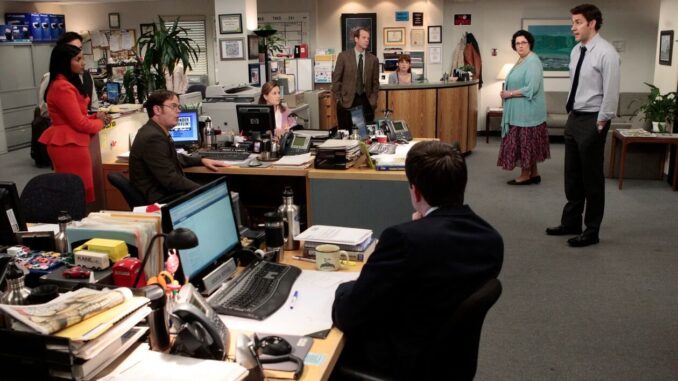
The flickering fluorescent light above my desk, eternally threatening to give up its ghostly glow, hummed a low, despairing tune. It was the unofficial anthem of OmniCorp Global Dynamics, a place widely, if unofficially, known as The Most Dysfunctional Office in America.
Stepping into OmniCorp was like entering a time capsule that had been stored in a damp basement for decades. The carpet, once a neutral beige, was now a mottled canvas of indeterminate stains, each an archaeological relic of spilled coffee, forgotten lunches, and possibly, shattered dreams. Desks, laden with the detritus of perpetual non-productivity, sagged under the weight of orphaned paperwork, defunct technology, and the emotional baggage of their inhabitants. The air, a stagnant soup of stale coffee, burnt microwave popcorn, and the faint, unsettling whiff of desperation, clung to everything.
At the heart of OmniCorp’s glorious disarray was its leadership, or lack thereof. Mr. Henderson, the CEO, was a man of grand, unachievable visions, usually announced during impromptu, rambling meetings that began with a bang and ended with a whimper, and never, ever, a clear directive. He’d vanish for days, only to reappear with a new "paradigm-shifting initiative" that contradicted the last, leaving his mid-level managers – a collection of perpetually overwhelmed, passive-aggressive automatons – to decipher his cryptic pronouncements. Their solution? More meetings. Meetings to discuss meetings, meetings to decide who should attend the next meeting, and meetings that spiraled into tangential discussions about optimal coffee bean grind or the best brand of paper clips. No decision was ever made; instead, issues were politely, if firmly, tabled, like fragile old ladies, for an eternity.
Then there were the denizens of this peculiar purgatory. Brenda from Accounting, a woman whose true calling was undoubtedly espionage, knew more about your personal life than your therapist. Her whispers carried the weight of a decree, shaping the office's social landscape with a delicate balance of fabricated gossip and meticulously observed truths. She operated the communal microwave with the precision of a bomb disposal expert, always timing her popcorn to burn just enough to permeate the entire office with an acrid cloud, ensuring everyone knew she was present and accounted for.
Across the aisle sat Gary, from Sales – though no one was quite sure what he actually sold. Gary was a master of the performative hustle. He paced, he gesticulated wildly during phone calls that seemed to involve only him talking, he rearranged his stack of untouched folders with furious efficiency. His calendar was perpetually booked with "client lunches" and "strategic planning sessions" that left no paper trail or measurable output. Gary was always busy, yet somehow, never productive. He was the perpetual motion machine of inertia.
And then there was Mildred from HR, a woman whose default setting was "deeply disappointed." Every question, every request, every sigh from a colleague was met with a practiced frown and a litany of company policies that invariably prohibited the desired outcome. Morale, in Mildred’s domain, was not fostered; it was regulated, observed, and gently, but firmly, euthanized. The "Suggestion Box," perpetually overflowing with pleas for better coffee or functional printers, remained sealed shut, a poignant monument to unheard voices.
The infrastructure itself was a character. The single communal printer, an ancient beast named "The Daemon," frequently devoured documents whole, spewing forth mutilated pages like a disgruntled oracle. The internet, when it deigned to function, moved at the glacial pace of a philosophical debate, making remote work an ironic joke. The office plants, a collection of sickly spider plants and drooping ferns, seemed to embody the slow, wilting spirit of the employees, their leaves yellowed like old legal pads.
One Tuesday, a desperate email from Marketing bounced around the office: "Urgent! Client deadline in 2 hours! Need final approval from Henderson, input from Gary, and costings from Brenda!" The email went unacknowledged by Henderson, unread by Gary (who was "strategizing" off-site), and marked as "low priority" by Brenda (who was busy dissecting the new intern's shoe choice). The deadline passed. The client eventually left. It was just another Tuesday at OmniCorp.
OmniCorp Global Dynamics wasn't merely inefficient; it was an active force against progress. It didn't just stumble; it embraced falling. It was a testament to the idea that an office could exist not despite its dysfunction, but because of it, sustained by a delicate ecosystem of avoidance, miscommunication, and the sheer, unyielding force of inertia. As the flickering light above my desk finally gave up the ghost, plunging my cubicle into a partial gloom, I realized: The Most Dysfunctional Office in America wasn’t just a place of work. It was a monument to the human capacity for endurance, a living, breathing diorama of how much chaos can be tolerated before the whole shaky edifice finally, gloriously, collapses. Or, more likely, just continues its slow, humid, perpetually stalled hum into eternity.
